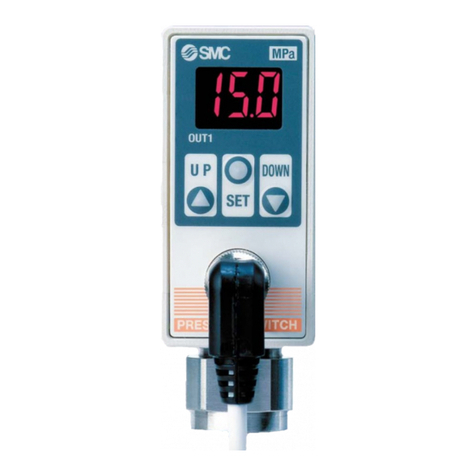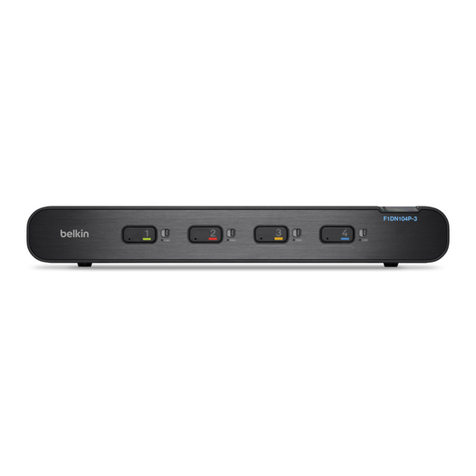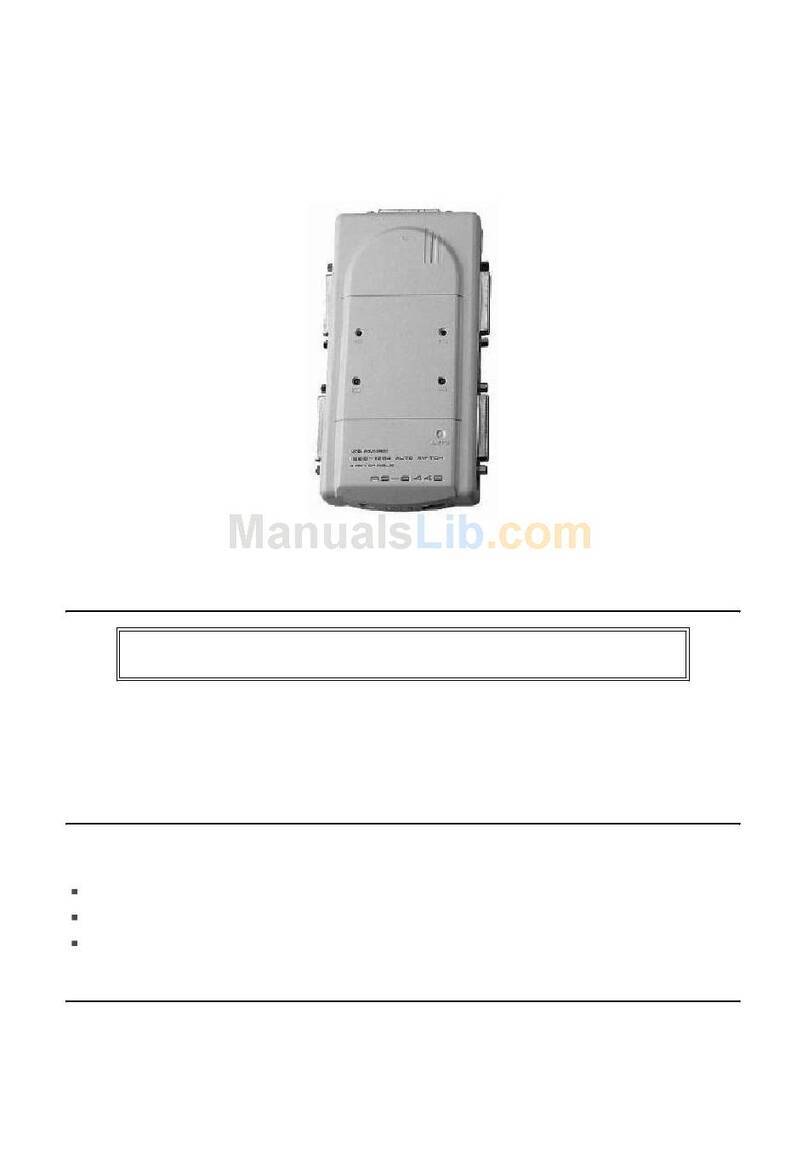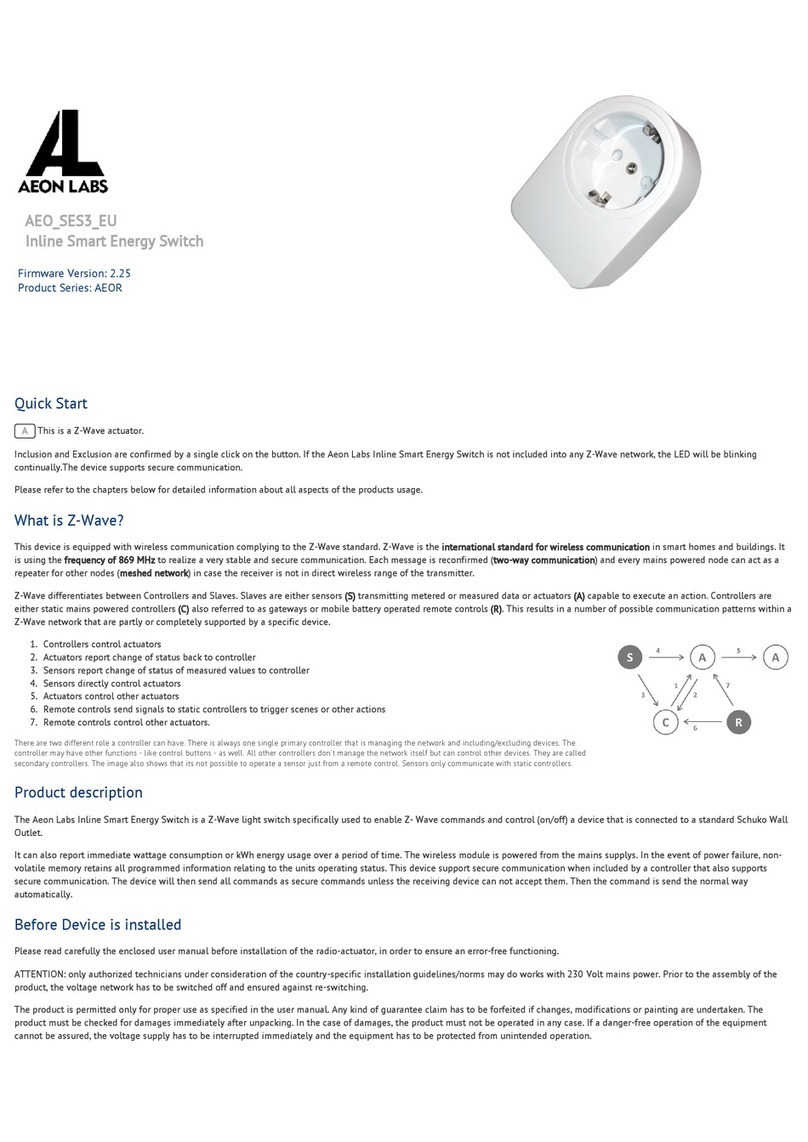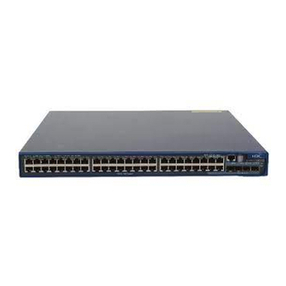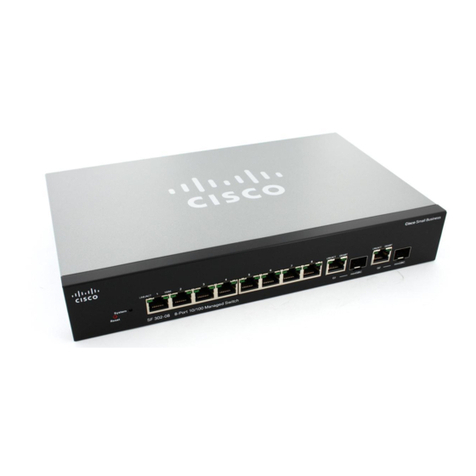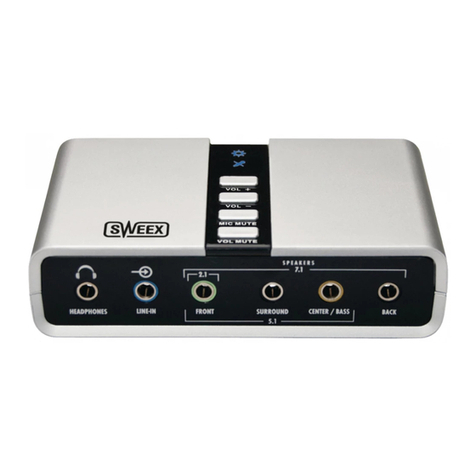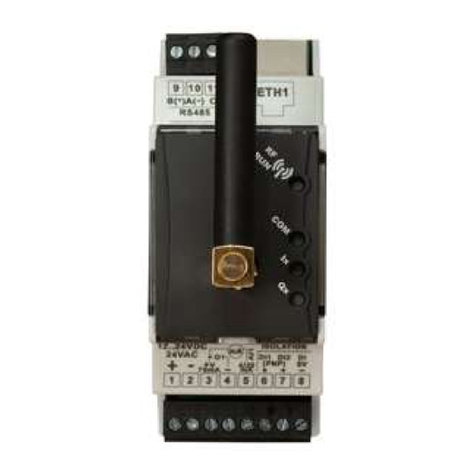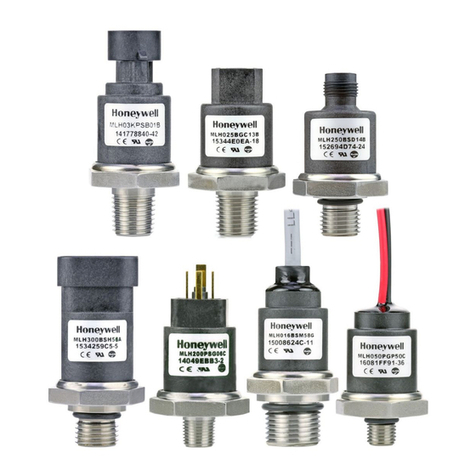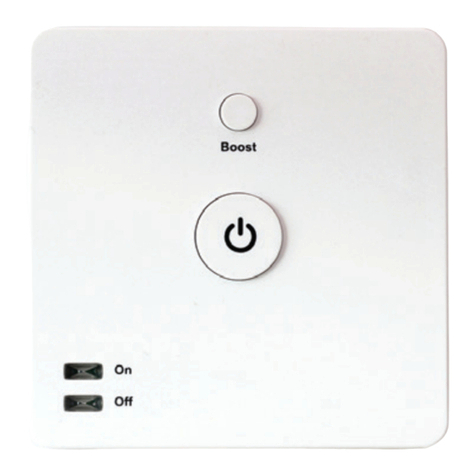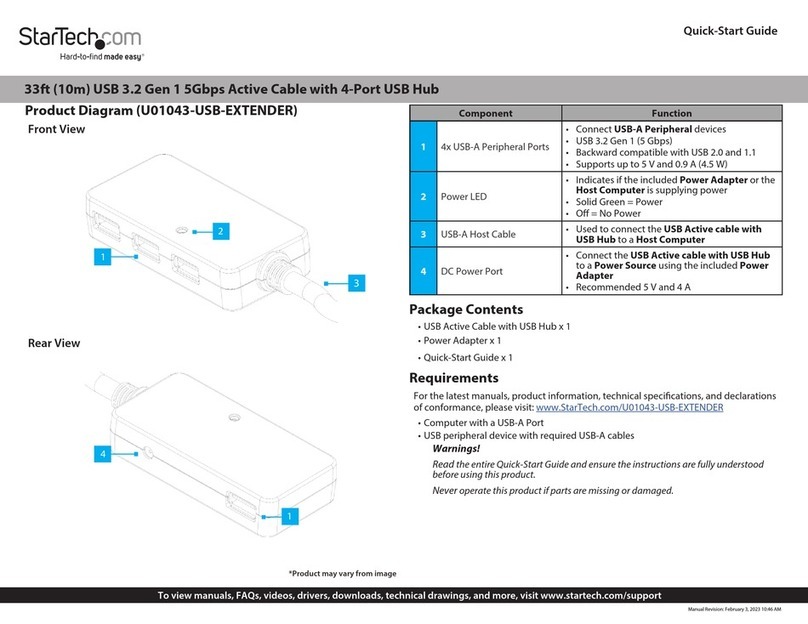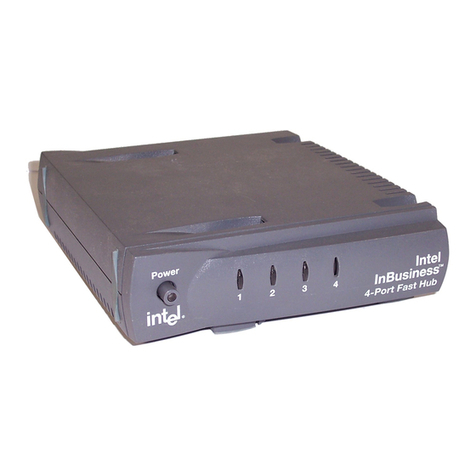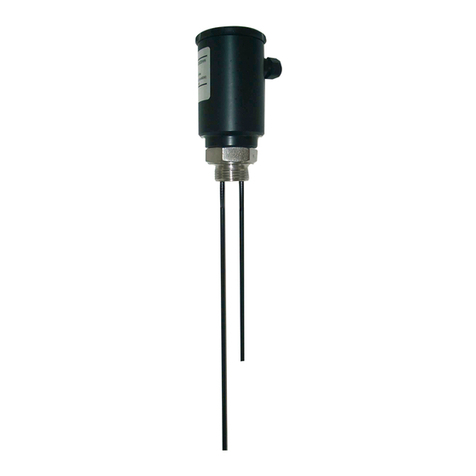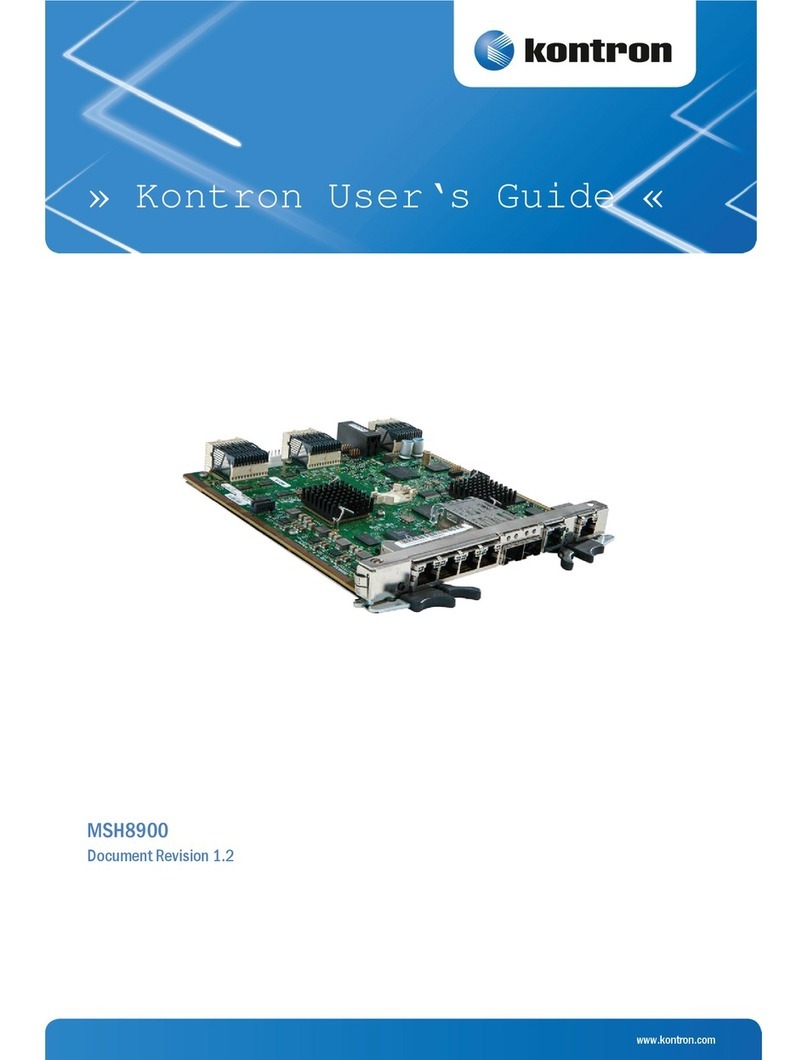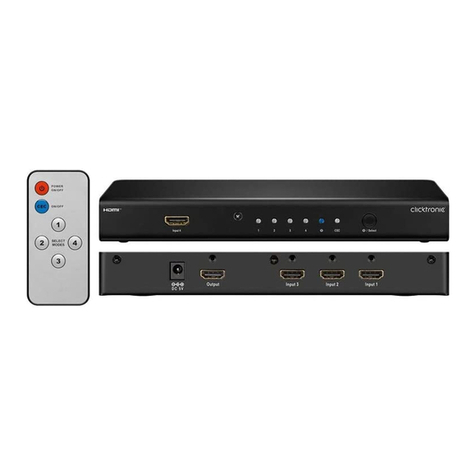Network Electronics WOS-2x1 User manual

network-electronics.com
2x1/2x2 Wideband Optical
Switch
Rev. 6
Flashlink User Manual
WOS-2x1/WOS-2x2
WOS-2x1L/WOS-2x2L

WOS-2x1 / WOS-2x2 Rev. 6
Network Electronics ASA, Thorøya, 3204 Sandefjord, Norway, Tel.:+47 33 48 99 99 Fax: +47 33 48 99 98
Technical specifications are subject to be changed without notice
2
Revision history
The latest version is always available in pdf-format on our web-site:
http://www.network-electronics.com/
Current revision of this document is the uppermost in the table below.
Revision Replaces Date Change Description
6 5 2007-10-30 AS New front page and removed old logo.
5 4 2007-10-05 AS Added Materials Declaration and EFUP
4 3 03.11.13 RS
Corrected GPI desc. for latching trigger types, added
information on adjustable delay for the latching tr. types
3 2 03.08.15 RS Added specification on multi mode switch
2 1 02.12.02 RS
Added information of latching trigger types WOS-2x1L
and WOS-2x2L, configuration examples for APS,
information on GYDA web interface and RS-422
commands
1 0 02.05.16 RS New description of GPI functionality (chapter 4.1)
0 A 01.10.24 RS Product release
A 01.09.13 RS Initial version

WOS-2x1 / WOS-2x2 Rev. 6
Network Electronics ASA, Thorøya, 3204 Sandefjord, Norway, Tel.:+47 33 48 99 99 Fax: +47 33 48 99 98
Technical specifications are subject to be changed without notice
3
Index
Revision history............................................................................................................................................2
1. General......................................................................................................................................................4
2. Specifications............................................................................................................................................5
9/125um Single mode fiber ........................................................................................................................5
62.5/125um Multi mode fiber ....................................................................................................................5
Electrical....................................................................................................................................................5
3. Connector module....................................................................................................................................6
3.1 Field Modification Instruction, replacement of back plane and PCB.................................................6
3.2 Applying signals to the connector module...........................................................................................7
4. Module status ...........................................................................................................................................8
4.1 GPI – Module Status Outputs and switch alarm inputs, non-latching trigger type ...........................8
4.2 GPI – Module Status Outputs and switch alarm trigger inputs, latching trigger type ......................9
4.3 Front Panel – Status Monitoring.......................................................................................................10
4.4 GYDA System Controller...................................................................................................................11
4.5. RS-422 command set.........................................................................................................................14
5. Configuration and application examples.............................................................................................15
5.1. Automatic Protection Switching with WOS-2x1L.............................................................................15
5.2. Automatic Protection Switching with WOS-2x2L with monitoring of standby fiber........................15
5.3. DWDM + Automatic Protection Switching with WOS-2x1L............................................................16
5.4. DWDM + APS with WOS-2x2L and monitoring of standby fiber....................................................16
6. Laser safety precautions........................................................................................................................17
Declaration of conformity with CE..........................................................................................................18
General environmental requirements for flashlink®equipment ..........................................................18
Product Warranty .....................................................................................................................................19
Materials declaration and recycling information ...................................................................................20
Materials declaration ................................................................................................................................20
Environmentally-friendly use period.......................................................................................................20
Recycling information ...............................................................................................................................21

WOS-2x1 / WOS-2x2 Rev. 6
Network Electronics ASA, Thorøya, 3204 Sandefjord, Norway, Tel.:+47 33 48 99 99 Fax: +47 33 48 99 98
Technical specifications are subject to be changed without notice
4
1. General
Figure 1: Block diagram of the WOS-2x1 and
WOS-2x1L operation. Main position.
Figure 2: Block diagram of the WOS-2x2 and
WOS-2x2L operation. Standby position,
The flashlink ® 2 x 1 Wideband Optical Switch and 2x2 Wideband Optical Switch are fiber optical SPDT
(Single Pole Double Throw) changeover modules for use together with the WOS-C1 connector module.
Typical applications for these units are selective routing of optical signal paths without optical-to-
electrical conversion and Automatic Protection Switching (APS). The units are controlled via the
flashlink ® GYDA control system or the GPI interface.
The optical switches operate in the 2nd and 3rd optical windows (1310nm and 1550nm)
The WOS-2x1 has two input/output ports and one common port.
The WOS-2x2 has two input ports and two output ports.
The product is available in four different versions all delivered with WOS-C1 connector module:
WOS-2x1 2x1 Wideband Optical Switch, non-latching trigger type For selective routing
WOS-2x2 2x2 Wideband Optical Switch, non-latching trigger type For selective routing
WOS-2x1L 2x1 Wideband Optical Switch, latching trigger type For APS
WOS-2x2L 2x2 Wideband Optical Switch, latching trigger type For APS

WOS-2x1 / WOS-2x2 Rev. 6
Network Electronics ASA, Thorøya, 3204 Sandefjord, Norway, Tel.:+47 33 48 99 99 Fax: +47 33 48 99 98
Technical specifications are subject to be changed without notice
5
2. Specifications
9/125um Single mode fiber
Optical wavelength: 2nd & 3rd opt. windows (1290-1570nm)
Insertion loss: 1.4dB typ, max 2.1dB incl. connectors
Connector return loss: >40dB w/SM fiber
Cross-talk: <-80dB
Repeatability: +/- 0.01dB
Durability: 10 000 000 cycles
Switching time: <50ms typ.
Switching time, latching versions: <200ms typ.
Connector: SC/UPC
62.5/125um Multi mode fiber
Optical wavelength: 2nd opt. window (1310nm)
Insertion loss: 1.4dB typ, max 2.1dB incl. connectors
Connector return loss: >20dB w/SM fiber
Cross-talk: <-80dB
Repeatability: +/- 0.01dB
Durability: 10 000 000 cycles
Switching time: <50ms typ.
Switching time, latching versions: <200ms typ.
Connector: SC/UPC
Electrical
Power: +5V DC / 1W
Control:
Control system for access to setup and module status with
BITE (Built-In Test Equipment).

WOS-2x1 / WOS-2x2 Rev. 6
Network Electronics ASA, Thorøya, 3204 Sandefjord, Norway, Tel.:+47 33 48 99 99 Fax: +47 33 48 99 98
Technical specifications are subject to be changed without notice
6
3. Connector module
3.1 Field Modification Instruction, replacement of back plane and PCB.
This Field Modification Instruction from Network Electronics ASA shows how to replace the back plane
on the flashlink frame. For questions please contact our office on tel: +47 33 48 99 99 (0800-1600 CET),
after closing time please use our service tel: +47 90 60 99 99
1. If there is installed a board in the actual slot from earlier, carefully remove this board first.
2. Carefully remove all 4 screws (2 screws if a blank back plane is mounted) from the back plane to
be replaced.
3. Insert the new back plane carefully. Use your business card (or another suitable card), as shown in
figure A below, to avoid that the EMC shield is damaged when inserting the new back plane.
Fi
g
ure A.
Fi
g
ure B.
4. Before tightening the screws, use one of your fingers to force the back plane to the bottom of the
frame as shown in figure B. Tighten the 2 screws at the bottom at the back plane first. This is to
avoid mismatch between the connector on the back plane and the PCB.
5. When inserting the new module for the first time, make sure that the connector on the PCB aligns
with connector on the back plane.
NOTE!
The PCB shall enter the back plane connector easily.

WOS-2x1 / WOS-2x2 Rev. 6
Network Electronics ASA, Thorøya, 3204 Sandefjord, Norway, Tel.:+47 33 48 99 99 Fax: +47 33 48 99 98
Technical specifications are subject to be changed without notice
7
Figure 3: Overview of the WOS-C1 connector
module for 2x1 switch configuration
Figure 4: Overview of the WOS-2x2 connector
module for 2x2 switch configuration
If a module is placed in the position left to the module (as seen from the rear), a rubber plug must replace
the spring-loaded plastic shield of the fiber adapter.
3.2 Applying signals to the connector module
The optical connection is an SC/UPC connector with a return loss better than 40dB typ.
According to SMPTE specifications, the return loss shall be better than 26 dB.
WOS-2x1 and WOS-2x1L:
With reference to figure 3:
WOS-2x2 and WOS-2x2L:
With reference to figure 4:
Conn. mod. port Switch port Conn. mod. port Switch port
OPT 1 Not used OPT 1 Input 1
OPT 2 Output 1(*) OPT 2 Output 1
OPT 3 Common OPT 3 Input 2
OPT 4 Output 2(*) OPT 4 Output 2
(*) Can also be used as input port, meaning that both 2x1 and 1x2 functionality can be implemented.

WOS-2x1 / WOS-2x2 Rev. 6
Network Electronics ASA, Thorøya, 3204 Sandefjord, Norway, Tel.:+47 33 48 99 99 Fax: +47 33 48 99 98
Technical specifications are subject to be changed without notice
8
4. Module status
The status of the module can be monitored in four ways.
1. GPI at the rear of the sub-rack.
2. LEDs at the front of the sub-rack.
3. GYDA-SC controller.
4. Directly accessing the RS-422 bus.
Of these four, the GPI and the LEDs are mounted on the module itself, whereas the GYDA-SC controller
is a separate module giving access to remote monitoring of the status of the card through either a web
interface or SNMP. The functions of the GPI and the LEDs are described in sections 4.1 to 4.3.
The GYDA-SC controller is described in section 4.4. The commands the modules will respond to over the
RS-422 bus, can be found in section 4.5.
4.1 GPI – Module Status Outputs and switch alarm inputs, non-latching trigger type
These outputs can be used for wiring up alarms for third party control systems. The GPI output is an open
collector output, sinking to ground when an alarm is triggered. The GPI outlet is shown in figure 5. The
connector used is RJ-45.
Max output current: 100mA
Max output voltage: 30V
WOS-2x1/WOS-2x2 GPI pinning:
Signal Name Pin # Input/Output Mode
Status General error status for the module Pin 1 Output Open Collector
Standby Alarm when switch in standby mode Pin 2 Output Open Collector
Switch to standby mode Pin 5 Input
Switch to standby mode Pin 6 Input
Switch to standby mode Pin 7 Input
0V= standby
5V= main
Ground 0 volt pin Pin 8 0V
The switch is set in standby mode by sinking pin5, pin6 or pin7 to ground.
Pin6 and pin7 are hardwired as logical OR.
Figure 5: GPI Outlet

WOS-2x1 / WOS-2x2 Rev. 6
Network Electronics ASA, Thorøya, 3204 Sandefjord, Norway, Tel.:+47 33 48 99 99 Fax: +47 33 48 99 98
Technical specifications are subject to be changed without notice
9
4.2 GPI – Module Status Outputs and switch alarm trigger inputs, latching trigger type
These outputs can be used for wiring up alarms for third party control systems. The GPI output is an open
collector output, sinking to ground when an alarm is triggered. The GPI outlet is shown in figure 6. The
connector used is RJ-45.
Max output current: 100mA
Max output voltage: 30V
WOS-2x1/WOS-2x2 GPI pinning:
Signal Name Pin # Input/Output Mode
Status General error status for the module Pin 1 Output Open Collector
Standby Alarm when switch in standby mode Pin 2 Output Open Collector
Switch to standby mode Pin 5 Input
Reset switch to main position Pin 6 Input
Reset switch to main position Pin 7 Input
0V= standby
5V= main
Ground 0 volt pin Pin 8 0V
The switch is set in standby mode by sinking pin5 to ground. Pin6 and
pin7 are hardwired as logical OR and when either is sunk to ground, they
will reset the latching switch to main position. Resetting can also be done
with GYDA system controller.
Figure 6: GPI Outlet

WOS-2x1 / WOS-2x2 Rev. 6
Network Electronics ASA, Thorøya, 3204 Sandefjord, Norway, Tel.:+47 33 48 99 99 Fax: +47 33 48 99 98
Technical specifications are subject to be changed without notice
10
4.3 Front Panel – Status Monitoring
The status of the module can be easily monitored visually by the LEDs at the front of the module. The
LEDs are visible through the front panel as shown in figure 6.
Figure 7: Diode overview of WOS-2x1(L)/WOS-2x2(L)
Both WOS-2x1(L) and WOS-2x2(L) have 2 LEDs each showing a status corresponding to the GPI
outputs.
Diode \ state Red LED Green LED No light
Status Module is faulty
Module is OK
Module power is OK
Module has no power
Main/standby Switch in standby position Switch in main position

WOS-2x1 / WOS-2x2 Rev. 6
Network Electronics ASA, Thorøya, 3204 Sandefjord, Norway, Tel.:+47 33 48 99 99 Fax: +47 33 48 99 98
Technical specifications are subject to be changed without notice
11
4.4 GYDA System Controller
There are six different views in the GYDA System Controller. Each has its own menu-tab at the top.
•System (An overview of the system connected to the given Controller Card)
•Alarms (All alarms within the system.)
•Log (All events after power up of the GYDA System Controller)
•Config (TCP/IP and SNMP Configuration Settings)
•Manuals (All user manuals in PDF-format)
•About
The description of the GYDA System Controller is found in a separate user manual.
The GYDA System Controller has two different pages for the different modules (found under the tab
"System"). The information page for WOS-2x2 is shown in figure 10, and the corresponding
configuration page is shown in figure 11.
Module Information Page Module Configuration Page Open user manual
Figure 8: The icons for the different views in the "System" menu.
The modules have dedicated icons, which will appear in the corresponding position of the frame.
The icon for WOS-2x1/WOS-2x2 is:
Figure 9: The GYDA icon for WOS-2x1/WOS-2x2.
A live demonstration of the GYDA System Controller can be found on the web site:
http://gyda.network-electronics.com/

WOS-2x1 / WOS-2x2 Rev. 6
Network Electronics ASA, Thorøya, 3204 Sandefjord, Norway, Tel.:+47 33 48 99 99 Fax: +47 33 48 99 98
Technical specifications are subject to be changed without notice
12
Figure 10: The module information page in the GYDA System Controller of the WOS-2x2.
The GYDA System Controller identifies the position and the type of each module automatically. It will
display the card type, and the module-specific parameters.
In addition all active alarms for the module will be displayed. The same alarms can be found in the
separate alarms view of the GYDA System Controller.

WOS-2x1 / WOS-2x2 Rev. 6
Network Electronics ASA, Thorøya, 3204 Sandefjord, Norway, Tel.:+47 33 48 99 99 Fax: +47 33 48 99 98
Technical specifications are subject to be changed without notice
13
Figure 11: The configuration page in the GYDA System Controller of WOS-2x2
The configuration screen for the WOS-2x1/WOS-2x2 allows you to set the switch to main or standby
position, as shown in figure 11, this can be used for provisioning of fiber paths or resetting of the latching
switches.

WOS-2x1 / WOS-2x2 Rev. 6
Network Electronics ASA, Thorøya, 3204 Sandefjord, Norway, Tel.:+47 33 48 99 99 Fax: +47 33 48 99 98
Technical specifications are subject to be changed without notice
14
4.5. RS-422 command set
All commands follow the flashlink protocol, and can be used for direct access to the modules without use
of the GYDA-SC, or for third-party control system integration. The flashlink protocol can be found on
our web page http://www.network-electronics.com/
Command Response Comment
? See protocol description The "hello" command
main OK Switch to main position
standby OK Switch to standby position
stat
Vcc=…
One of the following:
•mode: main
•mode: standby
•mode: standby (gpi)
Relay failure
Module status
+5V voltage monitoring
Main position
Standby position
Standby pos. GPI active
Relay failure

WOS-2x1 / WOS-2x2 Rev. 6
Network Electronics ASA, Thorøya, 3204 Sandefjord, Norway, Tel.:+47 33 48 99 99 Fax: +47 33 48 99 98
Technical specifications are subject to be changed without notice
15
5. Configuration and application examples
5.1. Automatic Protection Switching with WOS-2x1L
Figure 12: Possible setup for APS functionality, standby fiber is not monitored.
5.2. Automatic Protection Switching with WOS-2x2L with monitoring of standby fiber
Figure 13: APS, with monitoring of standby fiber, main position.
Figure 14: APS, with monitoring of standby fiber, standby position.

WOS-2x1 / WOS-2x2 Rev. 6
Network Electronics ASA, Thorøya, 3204 Sandefjord, Norway, Tel.:+47 33 48 99 99 Fax: +47 33 48 99 98
Technical specifications are subject to be changed without notice
16
5.3. DWDM + Automatic Protection Switching with WOS-2x1L
Figure 15: DWDM with APS, without monitoring of standby fiber, main position.
5.4. DWDM + APS with WOS-2x2L and monitoring of standby fiber
Figure 16: DWDM with APS, with monitoring of standby fiber, main position.
Figure 17:DWDM with APS, with monitoring of standby fiber, standby position.

WOS-2x1 / WOS-2x2 Rev. 6
Network Electronics ASA, Thorøya, 3204 Sandefjord, Norway, Tel.:+47 33 48 99 99 Fax: +47 33 48 99 98
Technical specifications are subject to be changed without notice
17
6. Laser safety precautions
Guidelines to limit hazards from laser exposure.
All the available EO units in the flashlink®range include a laser.
Therefore this note on laser safety should be read thoroughly.
The lasers emit light at wavelengths around 1310 nm or 1550 nm. This means that the human eye cannot
see the beam, and the blink reflex can not protect the eye. (The human eye can see light between 400 nm
to 700 nm).
A laser beam can be harmful to the human eye (depending on laser power and exposure time). Therefore:
!! BE CAREFUL WHEN CONNECTING / DISCONNECTING FIBER PIGTAILS (ENDS).
NEVER LOOK DIRECTLY INTO THE PIGTAIL OF THE LASER/FIBER.
NEVER USE MICROSCOPES, MAGNIFYING GLASSES OR EYE LOUPES TO LOOK INTO A
FIBER END.
USE LASER SAFETY GOGGLES BLOCKING LIGHT AT 1310 nm AND AT 1550 nm
Instruments exist to verify light output power: Power meters, IR-cards etc.
flashlink®features:
All the laser module cards in the flashlink®product range, are Class 1 laser products according to
IEC 825-1 1993, and class I according to 21 CFR 1040.10 when used in normal operation.
More details can be found in the user manual for the FR-2RU-10-2 frame.
Maximum output power*: 5 mW.
Operating wavelengths: > 1270 nm.
*Max power is for safety analysis only and does not represent device performance.

WOS-2x1 / WOS-2x2 Rev. 6
Network Electronics ASA, Thorøya, 3204 Sandefjord, Norway, Tel.:+47 33 48 99 99 Fax: +47 33 48 99 98
Technical specifications are subject to be changed without notice
18
Declaration of conformity with CE
This apparatus meets the requirements of EN 55103-1 (November 1996) with regard to emissions, and
EN 55103-2 (November 1996) with regard to immunity; it thereby complies with the Electromagnetic
Compatibility Directive 89/336/EEC.
General environmental requirements for flashlink®equipment
1. The equipment will meet the guaranteed performance specification under the following environmental
conditions:
•Operating room temperature range 0°C to 50°C
•Operating relative humidity range up to 90% (non-condensing)
2. The equipment will operate without damage under the following environmental conditions:
•Temperature range -10°C to 55°C
•Relative humidity range up to 95% (non-condensing)
3. Electromagnetic compatibility conditions:
•Emissions EN 55103-1 (Directive 89/336/EEC)
•Immunity EN 55103-2 (Directive 89/336/EEC)

WOS-2x1 / WOS-2x2 Rev. 6
Network Electronics ASA, Thorøya, 3204 Sandefjord, Norway, Tel.:+47 33 48 99 99 Fax: +47 33 48 99 98
Technical specifications are subject to be changed without notice
19
Product Warranty
The warranty terms and conditions for the product(s) covered by this manual follow the General Sales
Conditions by Network Electronics ASA. These conditions are available on the company web site of
Network Electronics ASA:
www.network-electronics.com

WOS-2x1 / WOS-2x2 Rev. 6
Network Electronics ASA, Thorøya, 3204 Sandefjord, Norway, Tel.:+47 33 48 99 99 Fax: +47 33 48 99 98
Technical specifications are subject to be changed without notice
20
Materials declaration and recycling information
Materials declaration
For product sold into China after 1st March 2007, we comply with the “Administrative Measure on the
Control of Pollution by Electronic Information Products”. In the first stage of this legislation, content of
six hazardous materials has to be declared. The table below shows the required information.
Toxic or hazardous substances and elements
組成名稱
Part Name
鉛
Lead
(Pb)
汞
Mercury
(Hg)
镉
Cadmium
(Cd)
六价铬
Hexavalen
t
Chromium
(Cr(VI))
多溴联苯
Polybrominate
d biphenyls
(PBB)
多溴二苯醚
Polybrominate
d diphenyl
ethers
(PBDE)
WOS-2x1 / WOS-
2x2 X O O O O O
O: Indicates that this toxic or hazardous substance contained in all of the homogeneous materials for
this part is below the limit requirement in SJ/T11363-2006.
X: Indicates that this toxic or hazardous substance contained in at least one of the homogeneous
materials used for this part is above the limit requirement in SJ/T11363-2006.
Environmentally-friendly use period
The manual must include a statement of the “environmentally friendly use period”. This is defined as the
period of normal use before any hazardous material is released to the environment. The guidance on how
the EFUP is to be calculated is not finalised at the time of writing. See
http://www.aeanet.org/GovernmentAffairs/qfLeOpAaZXaMxqGjSFbEidSdPNtpT.pdf for an unofficial
translation of the draft guidance. For our own products, Network Electronics has chosen to use the 50
year figure recommended in this draft regulation.
Network Electronics suggests the following statement on An “Environmentally Friendly Use Period”
(EFUP) setting out normal use:
EFUP is the time the product can be used in normal service life without leaking the hazardous materials. We expect the normal
use environment to be in an equipment room at controlled temperature range (0ºC - 40ºC) with moderate humidity (< 90%, non-
condensing) and clean air, not subject to vibration or shock.
Further, a statement on any hazardous material content, for instance, for a product that uses some tin/lead
solders:
Where a product contains potentially hazardous materials, this is indicated on the product by the appropriate symbol containing
the EFUP. The hazardous material content is limited to lead (Pb) in some solders. This is extremely stable in normal use and the
EFUP is taken as 50 years, by comparison with the EFUP given for Digital Exchange/Switching Platform in equipment in
Appendix A of “General Rule of Environment-Friendly Use Period of Electronic Information Products”. This is indicated by the
product marking:
This manual suits for next models
3
Table of contents
